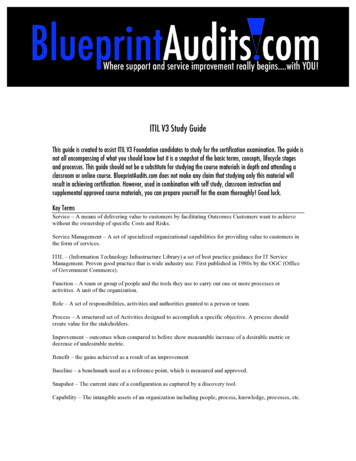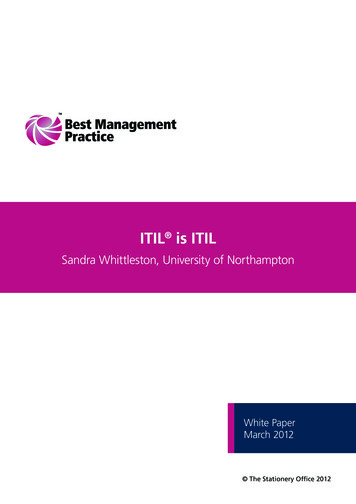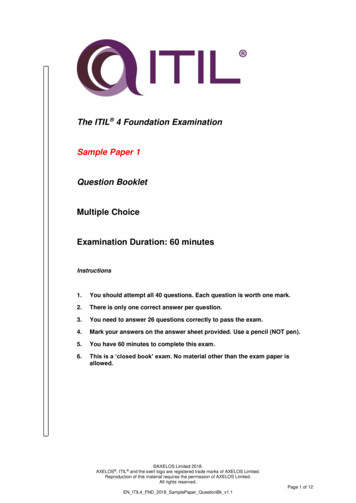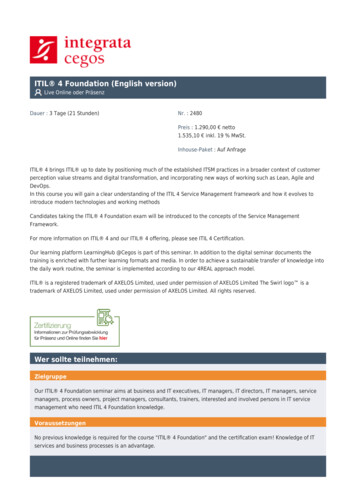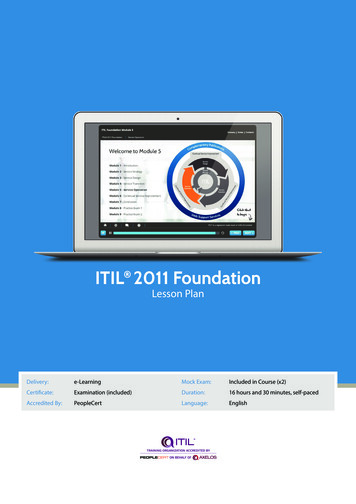
Transcription
ITIL 4 FOUNDATION STUDY NOTESITIL 4 FOUNDATION STUDY NOTESPass your ITIL exam with these comprehensive studynotes and exam tips.Version 2.0ITIL is a registered trade mark of AXELOS Limited, used under permission of AXELOS Limited.Copyright AXELOS Limited 2019. Used under permission of AXELOS Limited. All rights reserved.1
ITIL 4 FOUNDATION STUDY NOTESITIL is a registered trade mark of AXELOS Limited, used under permission of AXELOS Limited.Copyright AXELOS Limited 2019. Used under permission of AXELOS Limited. All rights reserved.2
ITIL 4 FOUNDATION STUDY NOTESITIL is a registered trade mark of AXELOS Limited, used under permission of AXELOS Limited.Copyright AXELOS Limited 2019. Used under permission of AXELOS Limited. All rights reserved.3
ITIL 4 FOUNDATION STUDY NOTESRead MeIf you’re reading this, you’ve stumbled upon the best study notes you’ll find for ITIL 4. Ourstudents have had great success with our online course using these notes. Still not convinced thatthese notes are awesome?Here’s how to use the notes:Order in which you should review the study materials:a. Exam Tipsb. Topic 1 – Introductionc. Topic 2 – Understanding the Key Concepts of Service Managementd. Topic 3 – ITIL Guiding Principlese. Topic 4 – The Four Dimensions of Service Managementf. Topic 5 – Purpose and Components of the ITIL Service Value Systemg. Topic 6 – Activities of the Service Value Chainh. Topic 7 – ITIL Practicesi.Topic 8 – Recap and Exam Practice1. The first page of every note contains a list of constructs (processes / functions / etc.) thatmay be tested on. If you can go through the first page of every topic andanswer/define/understand the constructs without looking at the answers listed on thesubsequent pages, you’re ready to move onto the next topic.2. While these notes are close to a complete study guide, keep in mind that getting answerswrong on the practice tests is an invaluable exercise which will help you determine theconstructs you still need to decipher. For example, I thought I knew what a “workaround”was, but I had to get it wrong on the practice exam to recognize I needed tounderstand/memorize ITIL’s definition.Best of luck! And hey, if you need help, don’t hesitate to contact us info@thoughtrock.comregardless of whether you’re taking the course through us. We’ll help!Your study partner, Thought RockVisit https://www.thoughtrock.com/ for more details.ITIL is a registered trade mark of AXELOS Limited, used under permission of AXELOS Limited.Copyright AXELOS Limited 2019. Used under permission of AXELOS Limited. All rights reserved.4
ITIL 4 FOUNDATION STUDY NOTESQuick Exam TipsPrepping for the ITIL 4 Foundation Exam? Here are some key points to keep in mind:1. Memorize your definitions. The questions on the exam will provide 2 out of 4 answersthat make sense and are very similar when referring to a term, and so if you don’t havethe term memorized, you’ll be stuck. Trust us; definition questions on the exam will bejust like this.2. Understanding the interrelationships, jurisdictions, and subtle differences between theterms, systems, and practices is just as important as understanding the constructsthemselves. For example: What is the difference between an organization provisioning services comparedto an organization receiving services? Which value chain activity includes negotiation of contracts and agreements withsuppliers and partners? What is the difference between output and outcome? Understand the service relationship model. Why are utility and warranty essential for a service to facilitate a desiredoutcome? What are the complex relationships between service providers, consumers andstakeholders? What is the difference between organizational agility and organizationalresilience? Describe the purpose of each service value chain activity. Understand the purpose of 15 ITIL practices and how an organization uses theseto perform work or accomplish an objective.ITIL is a registered trade mark of AXELOS Limited, used under permission of AXELOS Limited.Copyright AXELOS Limited 2019. Used under permission of AXELOS Limited. All rights reserved.5
ITIL 4 FOUNDATION STUDY NOTESTopic 1: IntroductionOutline About This TrainingAcknowledgementsWho Should Take This TrainingPurpose of the ITIL 4 TrainingAbout the ITIL StoryIT Service Management in theModern WorldHow Organizations AreTransformingAbout ITIL 4OverviewStructure and Benefits of ITIL 4Service Value System (SVS)Core Components of SVSFour Dimensions of ServiceManagementWhat You Need to KnowThis course is divided into topics. Each topic has objectives, content, and a quiz. This first topicprovides an overview of ITIL 4 and ITSM. Take a minute to read what you need to know.By the end of this topic, you will be able to: Understand the purpose of this training and who should take this trainingUnderstand IT Service Management in the modern world and how organizations aretransformingUnderstand the structure and benefits of ITIL 4Understand the Service Value System (SVS)Understand the core components of SVSUnderstand the four dimensions of Service ManagementITIL is a registered trade mark of AXELOS Limited, used under permission of AXELOS Limited.Copyright AXELOS Limited 2019. Used under permission of AXELOS Limited. All rights reserved.6
ITIL 4 FOUNDATION STUDY NOTESConcepts CoveredTake some time to review the concepts covered in this topic.Key ConceptPurpose of ITIL 4 FoundationMain PointsThe purpose of this training is to introduce learners to the management ofmodern IT-enabled services.Technology developmentSome of these developments include: Cloud computing Infrastructure as a service Machine learning Block chainITIL 4 frameworkConsists of the following key concepts: Service Value System (SVS) Four Dimensions ModelThe core components of the ITIL SVS are: ITIL service value chain ITIL practices ITIL guiding principles Governance Continual improvementCore components of SVSFour dimensions of servicemanagementThe four dimensions are:1. Organizations and people2. Information and technology3. Partners and suppliers4. Value streams and processesExam Recap Summary Understand the purpose of this training and who should take this trainingUnderstand IT Service Management in the modern world and how organizations aretransformingUnderstand the structure and benefits of ITIL 4Understand the Service Value System (SVS)Understand the core components of SVSUnderstand the four dimensions of Service ManagementITIL is a registered trade mark of AXELOS Limited, used under permission of AXELOS Limited.Copyright AXELOS Limited 2019. Used under permission of AXELOS Limited. All rights reserved.7
ITIL 4 FOUNDATION STUDY NOTESTopic 2: Understanding the Key Concepts of Service ManagementOutline What You Need to KnowKey TermsLesson ContentIntroductionValue and Value Co-creationOrganizations, Service Providers, Service Consumers and Other StakeholdersProducts and ServicesService RelationshipsValue: Outcomes, Cost and RisksSummaryCheck Your UnderstandingWhat You Need to KnowThis topic provides an understanding of the key concepts of service management. Take aminute to read what you need to know.By the end of this topic, you should be able to:1. Recall the following definitions: Service Utility Warranty Customer User Sponsor Service Management2. Describe the key concepts of creating value with services: Cost Value Organization Outcome Output RiskITIL is a registered trade mark of AXELOS Limited, used under permission of AXELOS Limited.Copyright AXELOS Limited 2019. Used under permission of AXELOS Limited. All rights reserved.8
ITIL 4 FOUNDATION STUDY NOTES Utility Warranty3. Describe the key concepts of service relationships: Service offering Service relationship management Service provision Service consumptionKey TermsTake some time to review the key terms covered in this topic.Key TermBusiness RelationshipManager (BRM)DefinitionA role responsible for maintaining good relationships with one or morecustomers.CostThe amount of money spent on a specific activity or resource.CustomerA person who defines the requirements for a service and takes responsibility forthe outcomes of service consumption.A person or a group of people that has its own functions with responsibilities,authorities and relationships to achieve its objectives.Organizations vary in size and complexity, and in their relation to legal entities,from a single person or a team, to a complex network of legal entities united bycommon objectives, relationships and authorities.OrganizationOutcomeA result for a stakeholder enabled by one or more outputs.OutputA tangible or intangible deliverable of an activity.ProductA configuration of an organization’s resources designed to offer value for aconsumer.RiskA possible event that could cause harm or loss, or make it more difficult toachieve objectives. Risk can also be defined as uncertainty of outcome, and canbe used in the context of measuring the probability of positive outcomes as wellas negative outcomes.ServiceA means of enabling value co-creation by facilitating outcomes that customerswant to achieve, without the customer having to manage specific costs and risks.Service ConsumptionActivities performed by an organization to consume services. It includes themanagement of the consumer’s resources needed to use the service, serviceactions performed by users, and the receiving (acquiring) of goods (if required).ITIL is a registered trade mark of AXELOS Limited, used under permission of AXELOS Limited.Copyright AXELOS Limited 2019. Used under permission of AXELOS Limited. All rights reserved.9
ITIL 4 FOUNDATION STUDY NOTESService ManagementA set of specialized organizational capabilities for enabling value for customers inthe form of services.Service OfferingA description of one or more services, designed to address the needs of a targetconsumer group. A service offering may include goods, access to resources, andservice actions.Service ProvisionService RelationshipManagementActivities performed by an organization to provide services.Includes: management of the provider’s resources, configured to deliver theservice, access to these resources for users, fulfilment of the agreed serviceactions, service performance management and continual improvement. It mayalso include the supply of goods.Joint activities performed by a service provider and a service consumer to ensurecontinual value co-creation based on agreed and available service offerings.SponsorA person who authorizes budget for service consumption.UserA person who uses services.UtilityThe functionality offered by a product or service to meet a particular need.ValueThe perceived benefits, usefulness and importance of something.WarrantyAssurance that a product or service will meet agreed requirements.Concepts CoveredTake some time to review the concepts covered in this topic.Key ConceptImportant concepts ofservice managementMain PointsThe most important concepts of service management, include: the nature of value and value co-creation organizations, service providers, service consumers and otherstakeholders products and services service relationships value: outcomes, costs and risksWhat is ServiceManagement?Service Management is a set of specialized organizational capabilities forenabling value for customers in the form of services.ValueIs a key focus of ITIL 4:Value is the perceived benefits, usefulness and importance of something.ITIL is a registered trade mark of AXELOS Limited, used under permission of AXELOS Limited.Copyright AXELOS Limited 2019. Used under permission of AXELOS Limited. All rights reserved.10
ITIL 4 FOUNDATION STUDY NOTESValue co-creationValue is co-created through an active collaboration between providers andconsumers, as well as other organizations that are part of the relevant servicerelationships.What is an organization?An organization is A person or a group of people that has its own functions withresponsibilities, authorities and relationships to achieve its objectives.Roles of organizationsOrganization provisions service then role is a service provider.Organization receiving services then role is a service consumer.Roles of service consumerCustomer – A person who defines the requirements for a service and takesresponsibility for the outcomes of service consumption.Sponsor – A person who authorizes budget for service consumption.User - A person who uses servicesOther stakeholdersThere are usually many other stakeholders that are important to value creation.Examples of these include: individual employees of the provider organization partners and suppliers investors and shareholders government organizations such as regulators, social groups,etc.Central component ofservice managementService - A means of enabling value co-creation by facilitating outcomes thatcustomers want to achieve, without the customer having to manage specificcosts and risks.How products offer valueProducts - A configuration of an organization’s resources designed to offer valuefor a consumer.Remember: A product is NOT exclusive to one consumer group, and can be usedto address the needs of several different groups. Products are typically complexand are not fully visible to the consumer.Different types of serviceofferingsService offering - A description of one or more services, designed to address theneeds of a target consumer group. A service offering may include: GOODS ACCESS TO RESOURCES SERVICE ACTIONSWhat is the differencebetween a product and aservice?Organizations will have their own definitions for product and service terms. Theimportant thing is to adopt a language that will allow the members of theorganization to talk together effectively and deliver objectives. The full valueITIL is a registered trade mark of AXELOS Limited, used under permission of AXELOS Limited.Copyright AXELOS Limited 2019. Used under permis
ITIL 4 FOUNDATION STUDY NOTES ITIL is a registered trade mark of AXELOS Limited, used under permission of AXELOS Limited. - -




